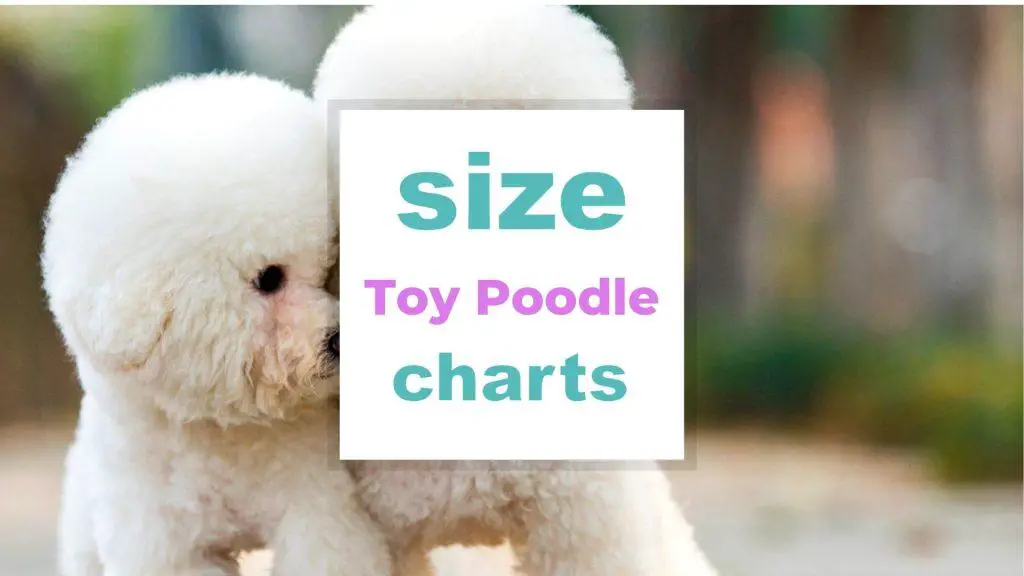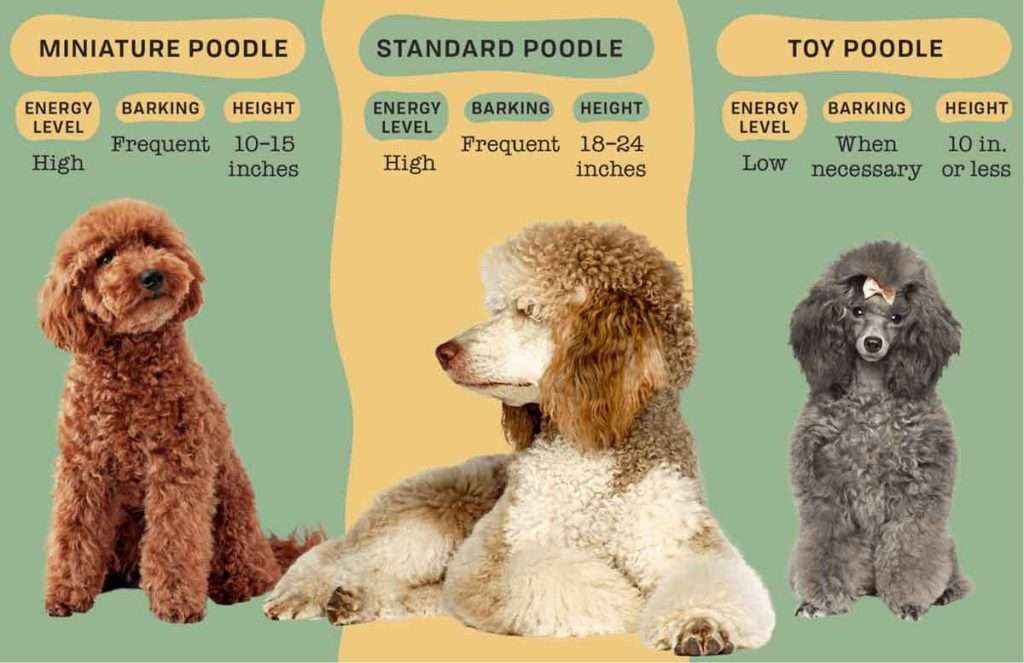Toy Poodle Size Chart by Age : How big will a Toy Poodle get?
The size and weight of a Toy Poodle are much smaller than those of a Standard or Miniature Poodle. Toy Poodles can grow no taller than 11 inches (28 cms), and most of them weigh between 6 and 10 pounds or a maximum of 4.5 kgs.

Jump directly to the Toy Poodle size and weight summary
Table of Content
- Weight and height of Toy poodles by age
- Toy Poodle Height by age
- Average Toy Poodle Facts and dimensions
- Comparison: Toy, Miniature and Standard poodle size
- Is a Toy Poodle the smallest?
- Conclusion
Toy Poodle Size Chart by Weight
Extra note for ease of use of this chart: Generally speaking, a puppy is officially considered an adult dog between the ages of 1 – 2 years, means a Toy poodle puppy weighs between 1.3 kg and 4 kgs (2.8 – 9 lbs)
| Toy Poodle Age | Male | Male | Female | Female |
| Average Weight | Normal Weight Range | Average Weight | Normal Weight Range | |
| 12 weeks (3 months) | 2.8 lbs 1.3 kg | 2.1 to 4.5 lbs 1 to 2 kg | 2.6 lbs 1.17 kg | 1.9 to 4.3 lbs 0.86 kg |
| 16 weeks (4 months) | 3.7 lbs 1.7 kg | 2.7 to 5.9 lbs 1.2 to 2.7 kg | 3.4 lbs 1.5 kg | 2.4 to 5.4 lbs 1.1 to 2.4 kg |
| 24 weeks (6 months) | 5.1 lbs 2.3 kg | 3.5 to 7.9 lbs 1.6 to 3.6 kg | 4.5 lbs 2.1 kg | 3.0 to 7.0 lbs 1.4 to 3.2 kg |
| 32 weeks (8 months) | 6.0 lbs 2.7 kg | 4.0 to 9.3 lbs 1.8 to 4.2 kg | 5.2 lbs 2.4 kg | 3.4 to 8.0 lbs 1.5 to 3.6 kg |
| 52 weeks (12 months) | 7.0 lbs 3.2 kg | 4.5 to 10.7 lbs 2.04 to 4.9 kg | 6.1 lbs 2.7 kg | 4.0 to 9.0 lbs 1.8 to 4.1 kg |
| 100 weeks | 8.0 lbs 3.6 kg | 5.2 to 11.6 lbs 2.4 to 5.3 kg | 7.2 lbs 3.3 kg | 4.8 to 10.0 lbs 2.2 to 4.5 kg |
Source: Info according to the Poodle Club of America (get more info)
Toy Poodle Height by age
A Toy poodle is fully grown by age 2, reaching a withers height of around 24 to 28 cms or 9.5”-11”. They have an overall body length of 12”-14” (30-41 cm), and a standing height between 13”-15” (33-38 cm)
Here are some extra tips to predict the adult height of your Toy poodle
– At 5 weeks, you can double the puppy’s height to get its adult height
– At 8 weeks, the pup should be under 18 cm in height, and will grow a further 10 cm
– At 10 weeks, the pup should be under 20 cm in height, will grow a further 4-8 cm
– At 12 weeks, pup should be under 22 cm in height, will grow a further 2-6cm
| Age | 3 months | 6 months | 12 months | Adult |
| Weight | 2 to 6 pounds | 4 to 8 pounds | 4 to 11 pounds | 4 to 12 pounds |
| Height | up to 8 inches | up to 9 inches | up to 10 inches | up to 10 inches |
Source: Wikipedia Type of Poodle
Average Toy Poodle Facts and dimensions
- Height: 13”-15” or 33-38 cm
- Length: 12”-14” or 30-41 cm
- Withers Height: 9.5”-11” or 24-28 cm
- Weight: 6-9 lb or 3-4 kg
- Withers Height (Male): 9.5”-11” or 24-28 cm
- Withers Height (Female): 9.5”-11” or 24-28 cm
- Lifespan: 12-18 years
Related: Dog Size Chart by breed and age: a complete guide for your dog’s needs.

Toy, Miniature, and Standard Poodle height size Chart
Let’s compare the size of the 3 types of poodles: Toy, Miniature and standard poodles. From the ground to the top of the shoulder blades is how tall a poodle is. The following is a size chart for the different poodles:
| Toy Poodles | Miniature Poodles | Standard Poodles | |||
| Weeks | Inches / cm | Weeks | Inches / cm | Weeks | Inches / cm |
| 5 | 5 in 12.7 cm | 8 | 8 –8.5 in 20.32 – 21.59 cm | 8 | 12 – 13 in 30.48 – 33.02 cm |
| 8 | 6 in 15.24 cm | 12 | 10 – 10.5 in 25.4 – 26.67 cm | 12 | 14 in 35.56 cm |
| 12 | 7 in 17.78 cm | 16 | 11 – 11.5 in 27.94 – 29.21 cm | 16 | 18 – 19 in 45.72 – 48.26 cm |
| 16 | 8 in 20.32 cm | 24 | 13.5 – 14 in 34.29 – 35.56 cm | 24 | 21 in + 53.34 cm + |
| 20 | 9 in 22.86 cm | x | x | 24 Months | 24 – 27 in 60.96 – 68.58 cm |
| 24 | 10 in 25.4 cm | x | x | x | x |
Is a Toy Poodle the smallest?
The smallest of the poodles is the Teacup poodle, which typically weighs between 2 and 4 pounds and has a maximum height of 8 inches.
| Toy Poodle | Miniature Poodle | Teacup Poodle | |
| Size | 9-11 inches; 5-9 pounds | 11-15 inches; 14-17 pounds | 5-8 inches; 2-4 pounds |
| Appearance | In between miniature and teacup sizes | The largest of the poodle varieties | The smallest of the poodle varieties |
| Ancestry | Unknown, but used in a variety of jobs including circus performing | Bred shortly after the standard poodle gained popularity | A recent breed, made to be an even smaller variety of toy poodle for designer purposes |
| Behavior | Friendly and smart; ideal for some families and situations | Intelligent and easy to train; ideal performer and family companion | Small and sweet, but extremely delicate; not ideal for many families or busy households |
| Lifespan | 11-14 years | 12-15 years | 10-13 years |
Conclusion
Toy Poodles can grow no taller than 11 inches (28 cms), and most of them weigh between 6 and 10 pounds or a maximum of 4.5 kgs. A Toy poodle is fully grown by age 2, reaching a withers height of around 24 to 28 cms or 9.5”-11”. They have an overall body length of 12”-14” (30-41 cm), and a standing height between 13”-15” (33-38 cm)

